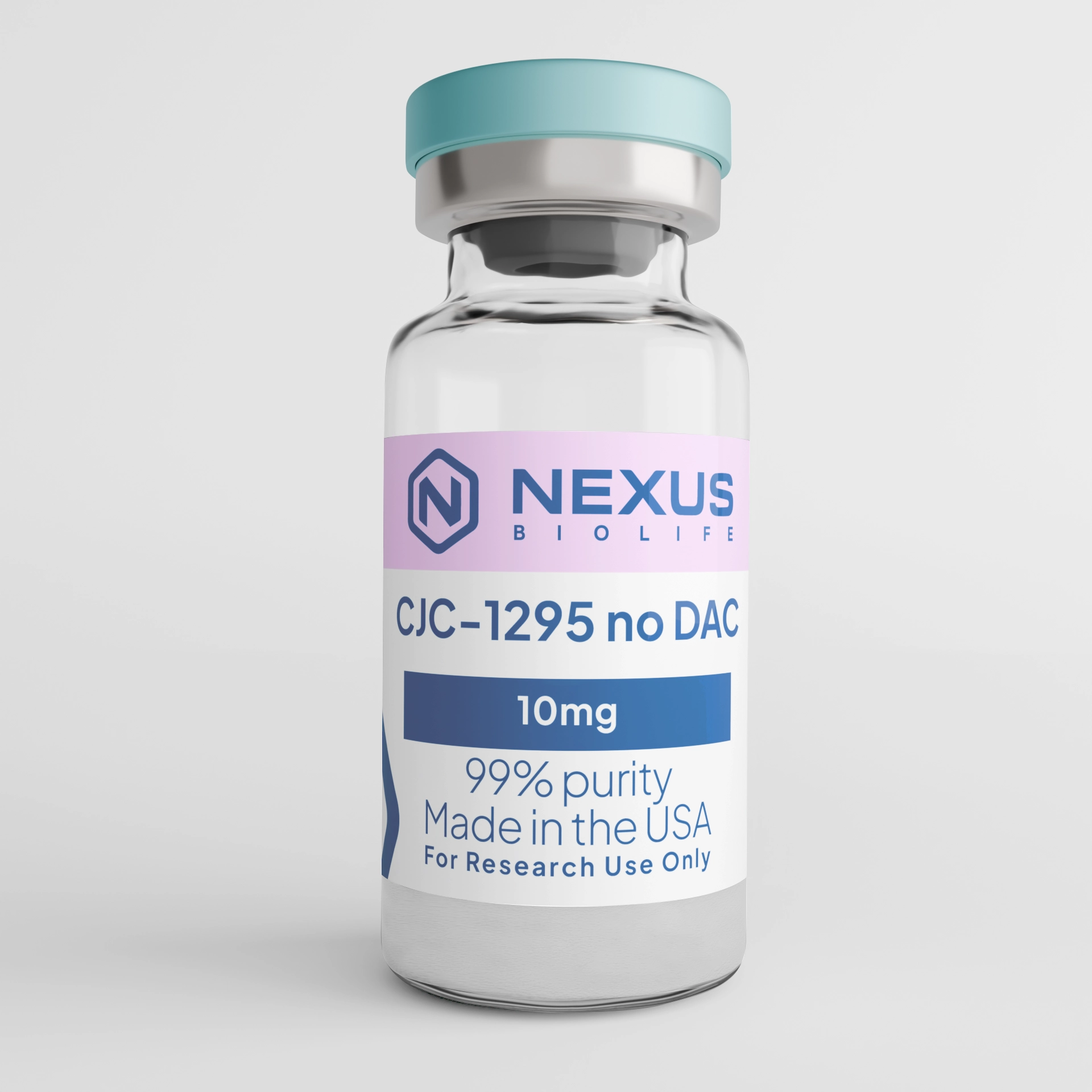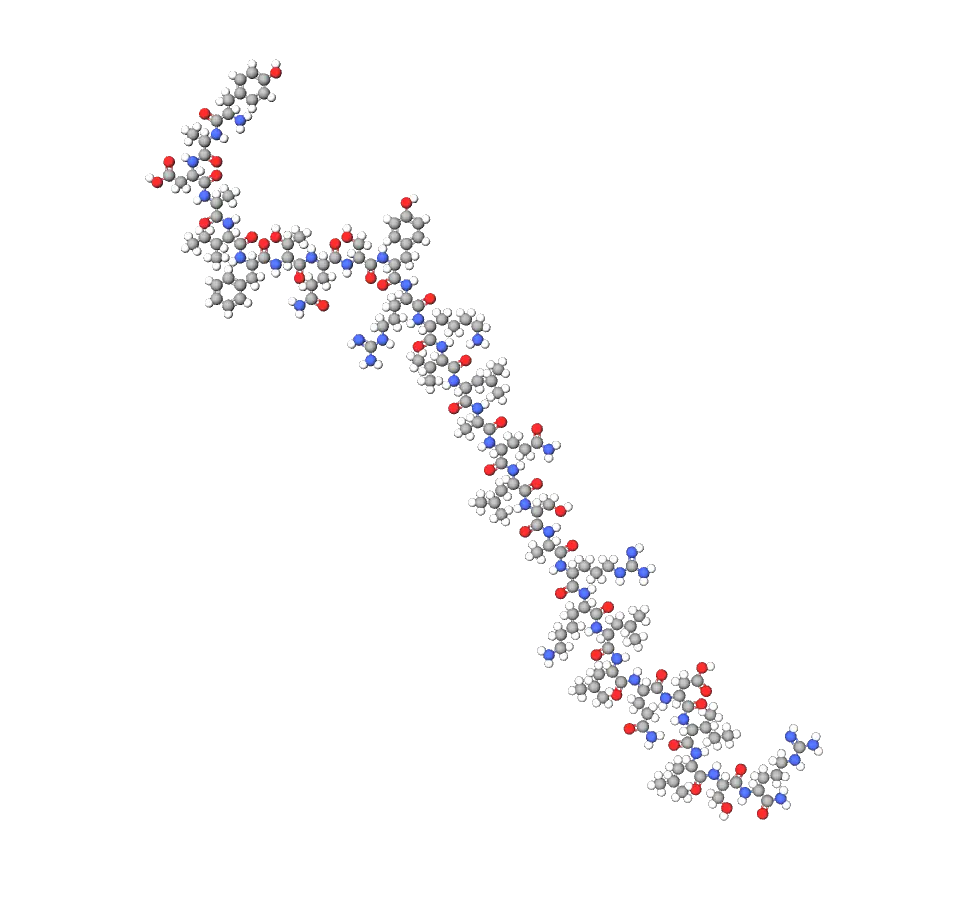
CJC-1295 no DAC is a synthetic peptide meticulously prepared for scientific inquiry. This product is synthesized with high purity for laboratory investigations. It is developed for use in various research applications. CJC-1295 no DAC is designated solely for research and development purposes.

Structurally, CJC-1295 no DAC is a modified version of GHRH (1-29), with key amino acid substitutions at positions 2 (D-Ala), 8 (Gln), 15 (Ala), and 27 (Leu) to enhance resistance to enzymatic breakdown and receptor affinity. Its full sequence is H-Tyr-D-Ala-Asp-Ala-Ile-Phe-Thr-Gln-Ser-Tyr-Arg-Lys-Val-Leu-Ala-Gln-Leu-Ser-Ala-Arg-Lys-Leu-Leu-Gln-Asp-Ile-Leu-Ser-Arg-NH2, yielding a molecular weight of approximately 3,367 g/mol. These alterations distinguish it from native GHRH, which is prone to rapid degradation, allowing for more consistent performance in lab assays.
In terms of physical properties, this peptide is typically supplied as a white lyophilized powder with high purity levels—our batches are verified to exceed 98% purity via HPLC and mass spectrometry analysis. It exhibits good solubility in aqueous buffers, but we advise careful handling to avoid aggregation. Unlike its DAC-conjugated counterpart, which extends half-life through albumin binding, CJC-1295 no DAC relies on its intrinsic modifications for stability, resulting in a shorter duration of action that mimics natural pulsatile GH release patterns. This makes it particularly suited for studies requiring transient stimulation rather than prolonged exposure.
CJC-1295 no DAC, also referred to as Modified GRF (1-29), is a synthetic analog of growth hormone-releasing hormone (GHRH) engineered to stimulate growth hormone (GH) secretion in experimental models. This 30-amino-acid peptide incorporates specific substitutions to improve stability and potency over native GHRH, making it a useful probe for in-vitro investigations into endocrine signaling and metabolic processes. As with all our offerings, CJC-1295 no DAC is provided exclusively for research purposes and in-vitro use only—not for human consumption or any clinical applications.
CJC-1295 no DAC functions as a GHRH receptor agonist, binding to receptors on pituitary somatotroph cells to trigger intracellular signaling cascades. Upon activation, it elevates cyclic AMP (cAMP) levels, which in turn promotes the exocytosis of GH vesicles, leading to increased GH secretion without affecting other pituitary hormones like ACTH or prolactin in most models. This selective action stems from its structural homology to native GHRH, but with enhanced potency due to the substitutions that reduce susceptibility to proteases like dipeptidyl peptidase-IV (DPP-IV).
In cellular assays, it has been observed to induce dose-dependent GH release, with effects amplified by phosphodiesterase inhibitors that sustain cAMP signaling. However, prolonged or high-dose exposure in some models may also influence DNA integrity markers, such as increased γH2AX, highlighting the need for controlled conditions in experiments. Overall, its mechanism provides a window into the GHRH-GH-IGF-1 axis, allowing researchers to explore feedback loops and downstream effects on metabolism and growth in isolated systems. We're always here to clarify these pathways—feel free to reach out if you'd like tips on assay design.
In essence, CJC-1295 no DAC serves as a precise and reliable instrument for dissecting the intricacies of GH regulation, offering researchers a short-acting GHRH mimic to uncover fundamental endocrine mechanisms in controlled settings. Its tailored structure and targeted action empower studies that advance our collective understanding of metabolic and growth processes, all while we uphold our dedication to transparency and excellence. Exclusively for in-vitro research, this peptide exemplifies our commitment to supporting your scientific journey with approachable expertise and unwavering integrity. Let's collaborate to illuminate the next breakthrough—one thoughtful experiment at a time.
This peptide finds broad utility in in-vitro and ex-vivo research focused on GH dynamics and related physiological processes. In pituitary cell cultures, CJC-1295 no DAC is commonly used to assess GH secretory responses, offering insights into receptor kinetics and signal transduction without the extended effects seen in DAC variants. Its short half-life—typically around 30 minutes in plasma models—enables studies of pulsatile hormone release, mimicking endogenous patterns more closely than longer-acting analogs.
Beyond basic endocrinology, it supports investigations into metabolic regulation, such as how GH influences insulin-like growth factor-1 (IGF-1) production in hepatocytes or adipocytes. Researchers have also employed it in combination with other secretagogues, like GHRP analogs, to examine synergistic effects on GH output and downstream anabolic pathways in tissue models. In detection and metabolism studies, its rapid breakdown by enzymes like DPP-IV provides a model for probing peptide pharmacokinetics and protease activity. We encourage exploring these applications responsibly, and our educational resources can help optimize protocols for reproducibility.
Proper storage and preparation are essential to preserve the integrity of CJC-1295 no DAC for your experiments. Store the lyophilized powder at -20°C or below in a desiccated environment to prevent moisture-induced degradation. For reconstitution, use sterile bacteriostatic water or a suitable buffer (e.g., 0.9% saline) to achieve concentrations of 1-2 mg/mL, gently swirling to dissolve without foaming. Avoid vigorous shaking, as it may denature the peptide.
Once reconstituted, solutions should be aliquoted and used promptly, with any remainder stored at 2-8°C for up to a week or frozen for longer periods—though we recommend fresh preparations for optimal activity. Our quality controls ensure minimal impurities, but always verify solubility and pH (aim for neutral) before use. If you encounter any handling questions, our team is ready to provide guidance based on best practices.
CJC-1295 no DAC, also referred to as Modified GRF (1-29), is a synthetic analog of growth hormone-releasing hormone (GHRH) engineered to stimulate growth hormone (GH) secretion in experimental models. This 30-amino-acid peptide incorporates specific substitutions to improve stability and potency over native GHRH, making it a useful probe for in-vitro investigations into endocrine signaling and metabolic processes. As with all our offerings, CJC-1295 no DAC is provided exclusively for research purposes and in-vitro use only—not for human consumption or any clinical applications.
CJC-1295 no DAC functions as a GHRH receptor agonist, binding to receptors on pituitary somatotroph cells to trigger intracellular signaling cascades. Upon activation, it elevates cyclic AMP (cAMP) levels, which in turn promotes the exocytosis of GH vesicles, leading to increased GH secretion without affecting other pituitary hormones like ACTH or prolactin in most models. This selective action stems from its structural homology to native GHRH, but with enhanced potency due to the substitutions that reduce susceptibility to proteases like dipeptidyl peptidase-IV (DPP-IV).
In cellular assays, it has been observed to induce dose-dependent GH release, with effects amplified by phosphodiesterase inhibitors that sustain cAMP signaling. However, prolonged or high-dose exposure in some models may also influence DNA integrity markers, such as increased γH2AX, highlighting the need for controlled conditions in experiments. Overall, its mechanism provides a window into the GHRH-GH-IGF-1 axis, allowing researchers to explore feedback loops and downstream effects on metabolism and growth in isolated systems. We're always here to clarify these pathways—feel free to reach out if you'd like tips on assay design.
In essence, CJC-1295 no DAC serves as a precise and reliable instrument for dissecting the intricacies of GH regulation, offering researchers a short-acting GHRH mimic to uncover fundamental endocrine mechanisms in controlled settings. Its tailored structure and targeted action empower studies that advance our collective understanding of metabolic and growth processes, all while we uphold our dedication to transparency and excellence. Exclusively for in-vitro research, this peptide exemplifies our commitment to supporting your scientific journey with approachable expertise and unwavering integrity. Let's collaborate to illuminate the next breakthrough—one thoughtful experiment at a time.
Structurally, CJC-1295 no DAC is a modified version of GHRH (1-29), with key amino acid substitutions at positions 2 (D-Ala), 8 (Gln), 15 (Ala), and 27 (Leu) to enhance resistance to enzymatic breakdown and receptor affinity. Its full sequence is H-Tyr-D-Ala-Asp-Ala-Ile-Phe-Thr-Gln-Ser-Tyr-Arg-Lys-Val-Leu-Ala-Gln-Leu-Ser-Ala-Arg-Lys-Leu-Leu-Gln-Asp-Ile-Leu-Ser-Arg-NH2, yielding a molecular weight of approximately 3,367 g/mol. These alterations distinguish it from native GHRH, which is prone to rapid degradation, allowing for more consistent performance in lab assays.
In terms of physical properties, this peptide is typically supplied as a white lyophilized powder with high purity levels—our batches are verified to exceed 98% purity via HPLC and mass spectrometry analysis. It exhibits good solubility in aqueous buffers, but we advise careful handling to avoid aggregation. Unlike its DAC-conjugated counterpart, which extends half-life through albumin binding, CJC-1295 no DAC relies on its intrinsic modifications for stability, resulting in a shorter duration of action that mimics natural pulsatile GH release patterns. This makes it particularly suited for studies requiring transient stimulation rather than prolonged exposure.

This peptide finds broad utility in in-vitro and ex-vivo research focused on GH dynamics and related physiological processes. In pituitary cell cultures, CJC-1295 no DAC is commonly used to assess GH secretory responses, offering insights into receptor kinetics and signal transduction without the extended effects seen in DAC variants. Its short half-life—typically around 30 minutes in plasma models—enables studies of pulsatile hormone release, mimicking endogenous patterns more closely than longer-acting analogs.
Beyond basic endocrinology, it supports investigations into metabolic regulation, such as how GH influences insulin-like growth factor-1 (IGF-1) production in hepatocytes or adipocytes. Researchers have also employed it in combination with other secretagogues, like GHRP analogs, to examine synergistic effects on GH output and downstream anabolic pathways in tissue models. In detection and metabolism studies, its rapid breakdown by enzymes like DPP-IV provides a model for probing peptide pharmacokinetics and protease activity. We encourage exploring these applications responsibly, and our educational resources can help optimize protocols for reproducibility.
Proper storage and preparation are essential to preserve the integrity of CJC-1295 no DAC for your experiments. Store the lyophilized powder at -20°C or below in a desiccated environment to prevent moisture-induced degradation. For reconstitution, use sterile bacteriostatic water or a suitable buffer (e.g., 0.9% saline) to achieve concentrations of 1-2 mg/mL, gently swirling to dissolve without foaming. Avoid vigorous shaking, as it may denature the peptide.
Once reconstituted, solutions should be aliquoted and used promptly, with any remainder stored at 2-8°C for up to a week or frozen for longer periods—though we recommend fresh preparations for optimal activity. Our quality controls ensure minimal impurities, but always verify solubility and pH (aim for neutral) before use. If you encounter any handling questions, our team is ready to provide guidance based on best practices.
